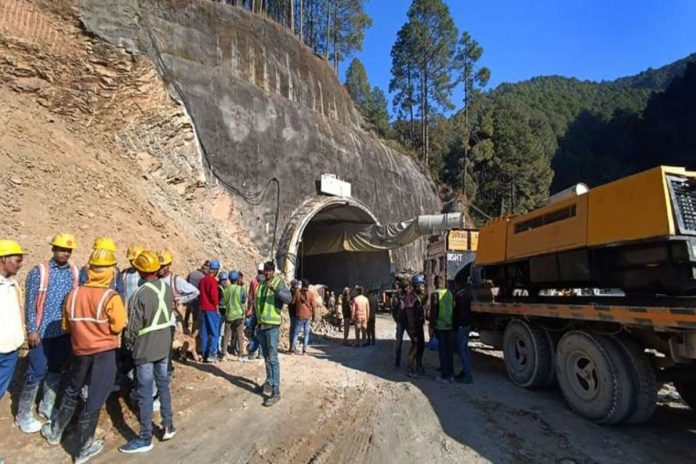The multi-agency operation to rescue the 41 workers trapped in a tunnel in Uttarkashi which collapsed last Sunday is in its final stage, according to officials.
However, a technical problem with the American Auger machine, which is inserting the 800 mm rescue pipes in the rubble to rescue the trapped workers, may slightly delay the evacuation process, according to local media reports.
Notable advancement was made in the rescue operation on Wednesday, which has experienced a series of highs and lows.
On Wednesday, rescue workers successfully bored through approximately 45 meters of rubble, behind which the workers are trapped, edging them closer to their final objective. An estimated 50-55 meters of debris is obstructing the tunnel.
In the evening, the rescue operation encountered another setback.
Around 6 pm, the pipes, through which the trapped individuals were to be extracted, could not be advanced further due to a metal girder obstructing the path. This necessitated the intervention of the NDRF team to manually remove the metal barriers from within the rescue pipes, causing a delay of several hours in the operation.
Prior to this, officials had predicted that the trapped men would be rescued by late Wednesday night or early Thursday morning.
Harpal Singh, the Zoji La tunnel project head, said two more pipes need to be inserted. Once the metal girders are cut, rescuers will resume the drilling.
Upon completion of the drilling, a 21-member team of NDRF officials, under the leadership of a commandant, is entrusted with the responsibility of extracting the workers one by one. Moreover, a medical team has also been sent to the location.
According to the reports, the rescue plan involves the use of wheeled, low-height stretchers to access the trapped workers using the pipes. NDRF team members, armed with oxygen kits, will navigate their way to the other side, bearing stretchers, ropes, and additional oxygen supplies for the workers.
An additional team from NDRF will stay put on the other side until the evacuation of all workers is complete. The evacuees, under the supervision of doctors, will be moved using separate ambulances that are positioned within the premises.
The workers will be transported to a hospital situated in Chinyalisaur, which is roughly 30 km away from the tunnel site, by these ambulances.
On Friday, the most substantial obstacle faced by the rescuers was when a heavy-duty drilling machine encountered issues at the 22-metre point in the rubble, causing a pause in the operation. However, after carrying out necessary repairs, the drilling process was resumed on Tuesday. By Wednesday evening, they had managed to insert a pipe into the wreckage, reaching a depth of 45 metres.
Despite the commencement of five rescue missions at the same time to save the men, the operation at the Silkyara end was deemed the most hopeful.
Mahmood Ahmad, who is the Managing Director of National Highways & Infrastructure Development Corporation Limited (NHIDCL), stated earlier in the day that rescuers opted to employ the “telescopic method” to push 800 mm pipes through the larger 900 mm pipes, which had become stuck and ceased to move.
Neeraj Khairwal, the Secretary of the Uttarakhand Government, announced that following the successful establishment of visual communication on Tuesday, officials have also managed to set up an audio communication channel. This was achieved by transmitting a microphone and speaker through a six-inch supply pipe.
“From our end, we communicated with them through headphones. Our medical professionals engaged in conversation with them via this medium, inquiring about their health status. A few individuals reported issues with constipation, for which we promptly supplied the necessary medication,” he explained.
The workers were supplied with fundamental items such as undergarments, towels, toothbrushes, and other necessary items. In addition, they were given a complete meal which included daal packed in plastic bottles, mixed vegetables, roti, and rice, all wrapped in aluminum foil.
The rescue operation is a collaborative effort involving five agencies – ONGC, SJVNL, RVNL, NHIDCL, and THDCL. They were each given specific tasks, with occasional modifications made for the sake of operational efficiency, as per the officials.


